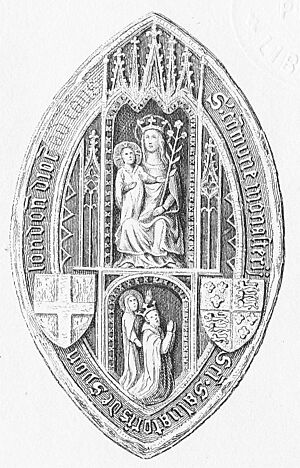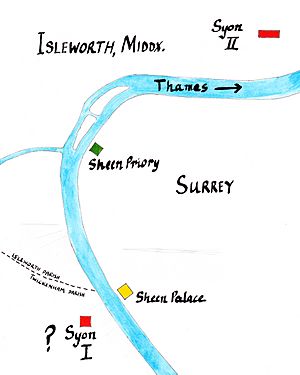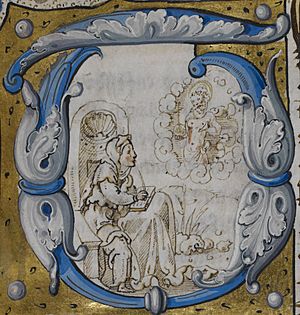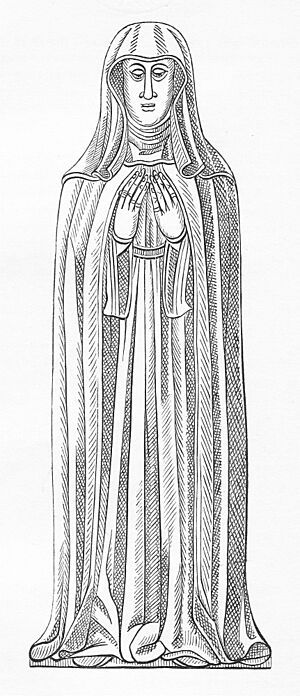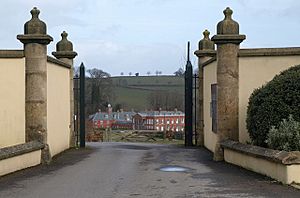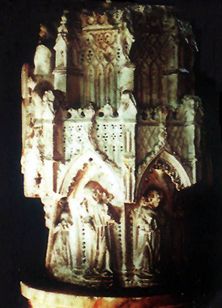Syon Abbey facts for kids
Syon Abbey, also known simply as Syon, was a monastery in England. It belonged to the Bridgettine Order. King Henry V founded it in 1415. The abbey was located on the north bank of the River Thames in Isleworth, Middlesex. Today, the grand house called Syon House stands near its original site. The abbey was named after the holy "City of David," also known as Zion, from the Bible.
When King Henry VIII closed down monasteries in England, Syon Abbey was the richest religious house in the country. It had a large library with books for both the monks and the nuns. One famous book, "The Orchard of Syon," was a special English translation of a work by Catherine of Siena made just for the nuns there.
Contents
- Building a Royal Legacy
- Starting the Abbey
- What's in a Name?
- The Bridgettine Order
- Who Lived There?
- Leaders of the Abbey
- Important Burials
- Moving to a New Home
- Building the New Abbey
- A Long Journey Home
- Coming Back to England
- King Henry VIII's Coffin
- Syon House Takes Its Place
- Digging Up the Past
- Syon Abbey's Collection
Building a Royal Legacy
Syon Abbey was part of a huge building project by King Henry V. This project was called “The King's Great Work.” It was centered around Sheen Palace, which was later renamed Richmond Palace. Sheen Palace was on the south side of the River Thames. Across the river, on the north side, were the areas of Twickenham and Isleworth.
Years before, King Richard II loved Sheen Palace. But after his wife, Anne of Bohemia, died there, he was so sad that he destroyed the palace. Later, King Henry IV took the throne. He felt guilty about some things he had done. He promised to build three monasteries to make up for his actions, but he died before he could do it.
His son, King Henry V, decided to finish his father's promise. He wanted to rebuild Sheen Palace and create the three monasteries. This showed a strong link between his family and the previous kings. So, the "Great Work" began in 1413. It included:
- A new Sheen Palace.
- The House of Jesus of Bethlehem of Sheen, for the Carthusian monks. This was built near the new palace.
- The Monastery of St Saviour and St Bridget of Syon, for the Order of St Augustine. This is the abbey we are talking about. Its first location was across the river from Sheen Palace, in Twickenham.
Starting the Abbey
King Henry V himself laid the first stone of Syon Abbey on February 22, 1415. This happened with the Bishop of London present. Nine days later, on March 3, 1415, the King signed the official document to create the abbey.
The exact first location of the abbey is not known for sure. However, it was definitely in the area of Twickenham, right across the Thames from Sheen Palace. Old records suggest it was in meadows that were once called "Isleworth Park" or "Twickenham Park." The King's document even described the size of the land. It was a shape with one long side facing the river.
What's in a Name?
The abbey's founding document said its full name should be: “The Monastery of St Saviour and St Bridget of Syon, of the Order of St Augustine.” Later, the nuns and monks sometimes added "the Saints Mary the Virgin" to the name.
Biblical Sion
The name "Syon" comes from "Sion" or "Zion" in the Latin Bible. Most mentions of Zion are in the Old Testament. Mount Zion was a strong fortress in Jerusalem. King David captured it around 1000 BC. He made it the capital of his kingdom. Later, his son Solomon built the Temple there, which was believed to be God's home. Because of this, Mount Zion is a very holy place for Jewish people and highly respected by Christians.
The Bridgettine Order
Syon Abbey followed the "Order of St Augustine," but it was a special kind called the "Order of St Saviour." This order was inspired by St Bridget. She was known for her visions, including seeing Jesus after his resurrection.
The Bridgettine Order was a changed version of the Augustinian order. They especially focused on the suffering of Christ and honoring the Virgin Mary. The Bridgettines first came to England from Sweden. A nobleman named Henry Lord Fitz-Hugh suggested to King Henry V that he should give one of his new monasteries to this order.
Who Lived There?
The abbey was designed to house 85 people. They lived in separate areas for men and women.
- Women (60):
* 1 Abbess (the head nun) * 59 Nuns
- Men (25):
* 1 Confessor General (the head priest for the community) * 12 Priests * 4 Deacons * 8 Lay Brethren (brothers who did practical work)
The Abbess was in charge of everyone. The "Abbess and Convent" was the legal group that managed the abbey's business.
Leaders of the Abbey
Only eight abbesses were elected to lead Syon Abbey:
- Matilda Newton (1418–1420)
- Joan North (1420–1433)
- Maud Muston (1433–1447)
- Margaret Ashby (1448–1456)
- Elizabeth Muston (1456–1497)
- Elizabeth Gibbs (1497–1518)
- Constance Browne (1518–1520)
- Agnes Jordan (1520–1539)
Important Burials
Some notable people were buried at Syon Abbey:
Moving to a New Home
Before 1431, the abbey received permission from King Henry VI to move. King Henry VI, son of the founder, was very supportive of Syon. The new location was about a mile and a half downstream, still on the riverbank, but in Isleworth parish.
The abbey already owned this new land since 1422. King Henry V had given the manor of Isleworth to Syon in his last year of life. The reason for the move was simple: they needed more space. The old monastery was too small and crowded for everyone. The new spot was chosen because it was "more meet healthful and salubrious" (healthier and better) for them.
Building the New Abbey
The official papers allowing the move, signed by King Henry VI in 1431, show that some new buildings were already finished. It seems that living quarters, or a "mansion," had been started years before 1431 and were already complete.
However, another building, possibly the main church, was still not finished by 1442. King Henry VI then gave special permission for the abbey to transport building materials easily. This meant that no one could take their masons, carpenters, or materials away from them while they were building.
Archaeological work suggests that the new church building might be partly under and to the east of the current Syon House.
The End of the Abbey
When King Henry VIII decided to break away from the Pope in 1534, many people at Syon Abbey supported him. But others refused to accept the King as the new head of the English Church.
One monk from Syon, Richard Reynolds, strongly opposed the King. He even helped Sir Thomas More, another opponent of the King, meet with a mystic woman. This made the King very angry at Syon. King Henry's minister, Thomas Cromwell, visited Syon to get the monks and nuns to agree to the King's new title. The monks were very stubborn. Some were sent away, and others were argued with by different church leaders, but they still refused. One monk, Whitford, even used the confessional (where people confess their sins) to speak against the King.
The nuns, however, were easier to convince. They all agreed to accept the King's new title, though probably unwillingly. They hoped their monastery would continue. But one nun, Agnes Smythe, tried to stop them from handing over the abbey's official seal, which was needed to sign the declaration.
On May 4, 1535, Richard Reynolds was executed for denying the King's power. He became a saint in the Catholic Church. Finally, in 1539, Syon Abbey was officially closed by the King. The community was forced to leave. The abbey was very wealthy, bringing in about £1,731 each year. The abbess, Agnes Jordan, received a large pension of £200, and the other nuns and monks also received pensions.
A Long Journey Home
Unlike many other religious groups, the Syon community did not break up. Instead, they went into exile in the Netherlands. They briefly returned to Syon in 1553 when the Catholic Queen Mary came to power. The abbey buildings were still standing.
However, when Queen Elizabeth became queen in 1558, she again closed down religious houses, including Syon. The nuns then received permission to leave England. After many difficulties traveling through France and Spain, they finally settled in Lisbon, Portugal, in 1594. While in Lisbon, they created a special illustrated request to the King of Spain, asking for help to return to England. This document is now kept at Arundel Castle.
Coming Back to England
The community from Lisbon returned to England in 1861. They first settled in Spetisbury, Dorset. Then they moved to Chudleigh, Devon, in 1887. Finally, in 1925, they moved to Marley House in Rattery, Devon. This house was renamed "Syon Abbey."
Syon Abbey had a special history because it was the only English religious community that survived the Reformation without breaking up. The Duke of Northumberland, who owns Syon House, even returned a piece of sculpted stonework from the original monastery to them. In 2004, the medieval books from the abbey's collection were given to the University of Exeter Library for safekeeping. In 2011, Syon Abbey, with only three elderly sisters left, closed down and was sold. The remaining sisters now live in Plymouth.
King Henry VIII's Coffin
On February 14, 1547, King Henry VIII's coffin stayed overnight at Syon Abbey. It was on its way from Westminster to be buried at St George's Chapel, Windsor. Years before, a friar named William Peyto had warned the King that "dogs would lick his blood," just as they had done to a wicked king named Ahab in the Bible. It is said that this prophecy came true that night at Syon. Some "bloody coloured matter" reportedly fell from the King's coffin onto the floor.
Syon House Takes Its Place
After the abbey was closed, the land was given to Edward Seymour, 1st Duke of Somerset. He was the protector of the young King Edward VI. He began building the first Syon House in the Italian Renaissance style. It seems he used parts of the old monastery church in his new house.
After the Duke was executed in 1552, the property went back to the Crown. Queen Mary briefly brought the nuns back to Syon from 1557 to 1558. But Queen Elizabeth I later gave the land to Henry Percy, 9th Earl of Northumberland in 1594. The square house you see today is a Georgian redesign of that first house. It was done by Hugh Percy, 1st Duke of Northumberland around 1760.
Digging Up the Past
Syon House is still the London home of the Dukes of Northumberland. In 2003, parts of the Monastery Church's foundations were found during archaeological digs. These digs were part of the Channel 4 TV show Time Team. The show suggested that the west end of the church might have been built into the current Syon House. However, later findings showed that the Tudor floor continued under the wall. This suggests that old medieval stones were simply reused when that part of the house was rebuilt in 1820. So far, experts don't know the exact length of the church or if it truly extends under Syon House. More excavations by Birkbeck, University of London continued from 2004 to 2011.
Syon Abbey's Collection
A large collection of items related to Syon Abbey is kept at the University of Exeter Special Collections. Most of this collection was given by the Syon Abbey sisters between 1990 and the abbey's closure in 2011. It includes the community's old records, handwritten books, and printed books.


